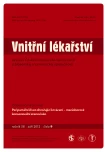A comparison of two methods of long-term external ECG telemonitoring in patients after ablation for atrial fibrillation
Authors:
J. Chovančík 1; V. Bulková 2; M. Fiala 1; J. Gandalovičová 2; Š. Královec 2; R. Neuwirth 1; H. Tolaszová 2; O. Jiravský 1; J. Brada 2; J. Januška 1
Authors‘ workplace:
Oddělení kardiologie Nemocnice Podlesí a. s., Třinec, přednosta prim. MUDr. Marian Branny
1; MDT – Medical Data Transfer, s. r. o, Brno, vedoucí pracovník Mgr. Veronika Bulková, Ph. D.
2
Published in:
Vnitř Lék 2012; 58(9): 633-639
Category:
Original Contributions
Overview
Aim:
The aim of the study was to compare two methods of long-term ECG monitoring after atrial fibrillation (AF) ablation.
Methods:
The study included 279 patients with paroxysmal (n = 163) or persistent (n = 116) AF, who were followed up for 1 year after the first catheter ablation for AF. All patients were provided with episodic ECG recorder for 1 year and instructed to send at least 2 random ECG recordings per day and whenever they sensed symptoms. They were also provided with external loop recorder for 2–3 weeks at 6 and 12 months to enable more continuous ECG monitoring.
Results:
At the end of 39 ± 12 (12–60) month follow-up, 143 (88%) patients with paroxysmal AF, and 105 (91%) patients with persistent AF, respectively, remained in stable sinus rhythm. The efficacy of episodic recorder expressed as a ratio of patients with identified AF/atrial tachycardia (AT) out of all patients with a documented episode of AF/AT was superior to the efficacy of loop recorder. No AF/AT episode was recorded with the loop recorder that was not also documented by the episodic recorder. Of the patients with the AF/AT recurrence detected by the episodic recorder, the arrhythmia was also revealed by the loop recorder in 70% of the patients after paroxysmal AF ablation (p < 0.001), and in 52% of the patients after persistent AF ablation (p = 0.006). Asymptomatic AF/AT was present in 42 (26%) of patients with paroxysmal AF, and in 28 (24%) patients with persistent AF (p = 0.810). From conventional follow-up unexpected and clinically significant episode of AF/AT that required change in therapy was detected in 9 (5.5%) patients after ablation for paroxysmal AF, and in 4 (3.4%) patients after ablation for persistent FS.
Conclusion:
More episodes of AF/AT after ablation were detected by 1-year daily ECG monitoring using episodic recorder as compared to periodic ECG monitoring with loop recorder. Identification of clinically significant episodes of AF/AT unrecognized from conventional follow-up was low.
Key words:
atrial fibrillation – catheter ablation – ECG monitoring
Sources
1. Wazni OM, Marrouche NF, Martin DO et al. Radiofrequency ablation vs antiarrhythmic drugs as first-line treatment of symptomatic atrial fibrillation: a randomized trial. JAMA 2005; 293: 2634–2640.
2. Pappone C, Augello G, Sala S et al. A randomized trial of circumferential pulmonary vein ablation versus antiarrhythmic drug therapy in paroxysmal atril fibrillation: the APAF study. J Am Coll Cardiol 2006; 48: 2340–2347.
3. Stabile G, Bertaglia E, Senatore G et al. Catheter ablation treatment in patients with drug-refractory atrial fibrillation: a prospective multi-centre, randomized, controlled study (Catheter Ablation For The Cure of Atrial Fibrillation Study). Eur Heart J 2006; 27: 216–221.
4. Jaïs P, Cauchemez B, Macle L et al. Catheter ablation versus antiarrhythmic drugs for atrial fibrillation: the A4 study. Circulation 2008; 118: 2498–2505.
5. Bulková V, Fiala M, Haman L et al. Zlepšení kvality života po ablaci dlouhodobě perzistentní versus paroxysmální fibrilace síní: výsledky dvouletého sledování. Vnitř Lék 2011; 57: 456–462.
6. Hsu LF, Jaïs P, Sanders P et al. Catheter ablation for atrial fibrillation in congestive heart failure. N Engl J Med 2004; 351: 2373–2383.
7. Gentlesk PJ, Sauer WH, Gerstenfeld EP et al. Reversal of left ventricular dysfunction following ablation of atrial fibrillation. J Cardiovasc Electrophysiol 2007; 18: 9–14.
8. Oral H, Chugh A, Özaydin M et al. Risk of thromboembolic events after percutaneous left atrial radiofrequency ablation of atrial fibrillation. Circulation 2006; 114: 759–765.
9. Nademanee K, Schwab MC, Kosar EM et al. Clinical outcomes of catheter ablation for high--risk patients with atrial fibrillation. J Am Coll Cardiol 2008; 51: 843–849.
10. Themistoclakis S, Corrado A, Marchlinski FE et al. The risk of thromboembolism and need for oral anticoagulation after successful atrial fibrillation ablation. J Am Coll Cardiol 2010; 55: 735–743.
11. Hindricks G, Piorkowski C, Tanner H et al. Perception of atrial fibrillation before and after radiofrequency catheter ablation: relevance of asymptomatic arrhythmia recurrence. Circulation 2005; 112: 307–313.
12. Piorkowski C, Kottkamp H, Tanner H et al. Value of different follow-up strategies to assess the efficacy of circumferential pulmonary vein ablation for the curative treatment of atrial fibrillation. J Cardiovasc Electrophysiol 2005; 16: 1286–1292.
13. Senatore G, Stabile G, Bertaglia E et al. Role of transtelephonic monitoring in detecting short-term arrhythmia recurrences after radiofrequency ablation in patients with atrial fibrillation. J Am Coll Cardiol 2005; 45: 873–876.
14. Neumann T, Ergodan A, Dill T et al. Asymptomatic recurrences of atrial fibrillation after pulmonary vein isolation. Europace 2006; 8: 495–498.
15. Edgerton JR, Mahoney C, Mack MJ et al. Long-term monitoring after surgical ablation for atrial fibrillation: how much is enough? J Thorac Cardiovasc Surg 2011; 142: 162–165.
16. Oral H, Veerareddy S, Good E et al. Prevalence of asymptomatic recurrences of atrial fibrillation after successful radiofrequency catheter ablation. J Cardiovasc Electrophysiol 2004; 15: 920–924.
17. Verma A, Minor S, Kilicaslan F et al. Incidence of atrial arrhythmias detected by permanent pacemakers (PPM) post-pulmonary vein antrum isolation (PVAI) for atrial fibrillation (AF): correlation with symptomatic recurrence. J Cardiovasc Electrophysiol 2007; 18: 601–606.
Labels
Diabetology Endocrinology Internal medicineArticle was published in
Internal Medicine

2012 Issue 9
Most read in this issue
- Superficial thrombophlebitis, unjustly underestimated disease – has the time come to change our view?
- Warning about risk of invasive infections in splenectomized patients. Experiences from University Hospital Brno, Czech Republic, in 2011
- Morbus Weil – a case study and principles
- Hyperventilation echocardiography in spastic angina pectoris diagnosing
